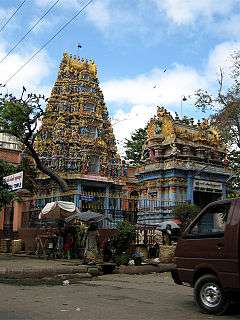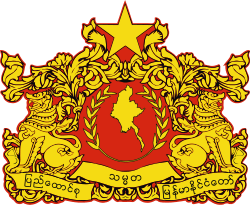India–Myanmar relations
 |
|
India |
Burma |
|---|---|
Bilateral relations between Burma (officially the Republic of the Union of Myanmar or the Union of Burma) and the Republic of India have improved considerably since 1993, overcoming tensions related to drug trafficking, the suppression of democracy and the rule of the military junta in Burma. Burma is located south of the states of Mizoram, Manipur, Nagaland and Arunachal Pradesh in Northeast India. The Indo-Burmese border stretches over 1,600 kilometeres.[1]
History


India had long historical relationship with Myanmar since antiquity, cultural exchanges included Buddhism and the Burmese script, which was based off the Indian Grantha script. In particular, Theravada Buddhism has tremendously influenced Burmese society and culture for millennia, with 90% continuing to follow the religion to this day.
Myanmar (formerly Burma) was made a province of British India by British rulers and again separated in 1937. India established diplomatic relations after Myanmar's independence from Great Britain in 1948. For many years, Indo-Burmese relations were strong due to Myanmar previously having been a province of India, due to cultural links, flourishing commerce, common interests in regional affairs and the presence of a significant Indian community in Myanmar.[1] India provided considerable support when Myanmar struggled with regional insurgencies. However, the overthrow of the democratic government by the Military of Myanmar led to strains in ties. Along with much of the world, India condemned the suppression of democracy and Myanmar ordered the expulsion of the Burmese Indian community, increasing its own isolation from the world.[1][2] Only China maintained close links with Myanmar while India supported the pro-democracy movement.[1][3][4]
A major breakthrough occurred in 1987 when the then-Indian Prime Minister Rajiv Gandhi visited Myanmar, but relations worsened after the military junta's reaction towards pro-democracy movements in 1988, which resulted in an influx of Burmese refugees into India.[1][3] However, since 1993 the governments of the Indian Prime Ministers P.V. Narasimha Rao and Atal Bihari Vajpayee changed course and began to establish warmer relations between the two nations, as part of a wider foreign policy of increasing India's participation and influence in Southeast Asia, in light of the growing influence of the People's Republic of China.[1][3][4]
Economic relations
India is the largest market for Burmese exports, buying about US$ 220 million worth of goods in 2000; India's exports to Burma stood at US$75.36 million.[1] India is Burma’s 4th largest trading partner after Thailand, China and Singapore, and second largest export market after Thailand, absorbing 25 percent of its total exports.[5] India is also the seventh most important source of Burma’s imports. The governments of India and Burma had set a target of achieving $1 billion and bilateral trade reached USD 650 million U.S. dollars by 2006.[5] The Indian government has worked to extend air, land and sea routes to strengthen trade links with Myanmar and establish a gas pipeline.[3][5] While the involvement of India's private sector has been low and growing at a slow pace, both governments are proceeding to enhance cooperation in agriculture, telecommunications, information technology, steel, oil, natural gas, hydrocarbons and food processing.[3][5] The bilateral border trade agreement of 1994 provides for border trade to be carried out from three designated border points, one each in Manipur, Mizoram and Nagaland.[5]
Infrastructure initiatives
On 13 February 2001 India and Burma inaugurated250 kilometre Tamu-Kalewa-Kalemyo highway, popularly called the Indo-Myanmar Friendship Road, built mainly by the Indian Army's Border Roads Organisation and aimed to provide a major strategic and commercial transport route connecting North-East India, and South Asia as a whole, to Southeast Asia.[1]
India-Myanmar-Thailand Friendship Highway
India and Myanmar have agreed to a 4-lane, 3200 km triangular highway connecting India, Myanmar and Thailand. The route, which is expected to be completed by sometime during 2016, will run from India's northeastern states into Myanmar, where over 1,600 km of roads will be built or improved.
The route begins from Guwahati in India and connects to Mandalay in Myanmar, route continues to Yangon in Myanmar and then to Mae Sot in Thailand, which then continues to Bangkok.
The first phase connecting Guwahati to Mandalay is set to complete by 2016. This will eventually be extended to Cambodia and Vietnam under Mekong-Ganga Cooperation within the wider framework of Asian Highway Network. This is aimed at creating a new economic zone ranging from Kolkata on the Bay of Bengal to Ho Chi Minh City on the South China Sea.[6]
As of Nov 2014, this project is likely to be completed and fully operational by 2016.[7]
Kaladan Multi-modal Transit Route
The Kaladan Multi-modal Transit Transport Project will connect the eastern Indian seaport of Kolkata with Sittwe seaport in Myanmar by sea; it will then link Sittwe seaport to Lashio in Myanmar via Kaladan river boat route and then from Lashio on to Mizoram in India by road transport. The project was scheduled to be completed by 2014 according to Governor of Mizoram Vakkom Purushothaman.,[8] but as of Nov 2014 it is likely to be completed by 2016.[7]
Development of strategic ties
India's move to forge close relations with Burma are motivated by a desire to counter China's growing influence as a regional leader and enhance its own influence and standing.[1][3][9] Concerns and tensions increased in India over China's extensive military involvement in developing ports, naval and intelligence facilities and industries, specifically the upgrading of a naval base in Sittwe, a major seaport located close to the eastern Indian city of Kolkata.[1] India's engagement of the Burmese military junta has helped ease the regime's international isolation and lessen Burma's reliance on China.[1] Both nations sought to cooperate to counteract drug trafficking and insurgent groups operating in the border areas.[3] India and Myanmar are leading members of BIMSTEC and the Mekong-Ganga Cooperation, along with Vietnam, Laos, Cambodia and Thailand, helping India develop its influence and ties amongst Southeast Asian nations.[1]
India was hesitant in reacting to the 2007 Burmese anti-government protests that had drawn overwhelming international condemnation.[9] India also declared that it had no intention of interfering in Burma's internal affairs and that the Burmese people would have to achieve democracy by themselves as it respects the sovereignty of Myanmar.[3] This low-key response has been widely criticised both within India and abroad as weakening India's credentials as a leading democratic nation.[1][3][9] Indo-Burma relations went into pleasant phase over Burmese steps towards democracy.
As of 2013, India has provided loan to Myanmar for its development, about US$500 million.[10]
India and Myanmar are set to cooperate in military and help modernize Myanmar's military.
See also
- Arunachal Border Highway
- Asian Highway Network
- India-Myanmar-Thailand Friendship Highway
- Foreign relations of Burma
References
- 1 2 3 4 5 6 7 8 9 10 11 12 13 "Asia Times: Myanmar shows India the road to Southeast Asia". Retrieved 2 April 2016.
- ↑ "Years of Isolation Produced Intensely Poor Nation". 24 July 1988. Retrieved 2 April 2016.
- 1 2 3 4 5 6 7 8 9 "BBC NEWS - South Asia - Explaining India's silence over Burma". Retrieved 2 April 2016.
- 1 2 Realism in India-Myanmar relations
- 1 2 3 4 5 "India-Myanmar trade relations". Retrieved 2 April 2016.
- ↑ "India to open super highway to Burma and Thailand". Telegraph.co.uk. 29 May 2012. Retrieved 2 April 2016.
- 1 2 Elizabeth Roche. "Highway linking India to Myanmar, Thailand likely by 2016: VK Singh". http://www.livemint.com/. Retrieved 2 April 2016. External link in
|work=(help) - ↑ Purushothaman, Vakkom. "Kaladan Multi Modal Transit Transport Project to link sea route in Myanmar with Mizoram". The Northeast Times. Retrieved 11 August 2012.
- 1 2 3 "India's Burma Silence Says Volumes". TIME.com. 29 September 2007. Retrieved 2 April 2016.
- ↑ Myanmar to use Indian bank loans for development
Further reading
- Amit Singh, "Emerging Trends in India-Myanmar Relations," Maritime Affairs: Journal of the National Maritime Foundation of India, Vol. 8, No. 2, (Dec 2012) Pages: 25-47 DOI:10.1080/09733159.2012.742650

